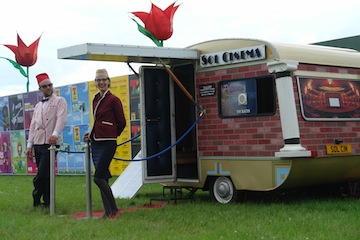Click here to print
Cinema from the Sun
posted March 17, 2014
Sol Cinema presents short films in a very small space
n
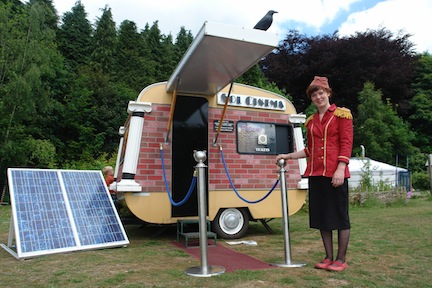 Do you have a mobile home to spare, whether you call it a caravan, Winnebago, or whatever?
Do you have a mobile home to spare, whether you call it a caravan, Winnebago, or whatever?
If you do, you might like to give the UK-based but eminently mobile Sol Cinema some competition for the title it claims: “the world’s smallest solar movie theatre.”
The operators of the theatre built it in 2009 from an abandoned caravan (trailer home) that they found derelict in a field, bought for £50, gutted, and installed with a theatre.
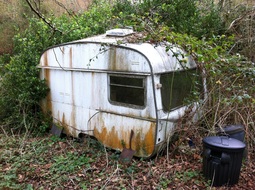 The result is Sol Cinema, a classic film house adapted — shrunk — to a very small space that can accommodate 8 adults or 12 children, a few more if attendees don’t mind squeezing up tight.
The result is Sol Cinema, a classic film house adapted — shrunk — to a very small space that can accommodate 8 adults or 12 children, a few more if attendees don’t mind squeezing up tight.
In the fetchingly refitted trailer, Sol Cinema shows 1- to 10-minute independent films from a library of comedies, documentaries, and short local films with environmental themes.
T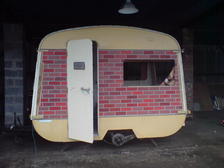 he cinema uses an LED video projector connected to a solar generator driven by a photovoltaic panel that collects power from the Sun to cast the light that projects the stars. “We offer something fun and unique to film lovers of all ages,” says Sol’s projectionist, Paul O’Connor, a filmmaker, himself. “We designed The Sol Cinema to support the growing number of short videos being made. We wanted to give a better experience than YouTube” for those.
he cinema uses an LED video projector connected to a solar generator driven by a photovoltaic panel that collects power from the Sun to cast the light that projects the stars. “We offer something fun and unique to film lovers of all ages,” says Sol’s projectionist, Paul O’Connor, a filmmaker, himself. “We designed The Sol Cinema to support the growing number of short videos being made. We wanted to give a better experience than YouTube” for those.
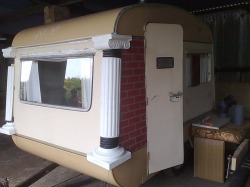 The scrounged caravan was a three-berth Euro-Camper, designed in 1965 to be towed by a British Leyland Mini. O’Connor and Furlong, a musician and the brains behind the scheme, called on two artists, Ami Marsden and Beth Marsden, to help with the refit. They used as much recycled and salvaged material as they could; the carpets and cushions, for example, came from a marquee hire company. They built tiered seating, upholstered plush seats, and attached mock brick cladding and theatrical pillars outside.
The scrounged caravan was a three-berth Euro-Camper, designed in 1965 to be towed by a British Leyland Mini. O’Connor and Furlong, a musician and the brains behind the scheme, called on two artists, Ami Marsden and Beth Marsden, to help with the refit. They used as much recycled and salvaged material as they could; the carpets and cushions, for example, came from a marquee hire company. They built tiered seating, upholstered plush seats, and attached mock brick cladding and theatrical pillars outside.
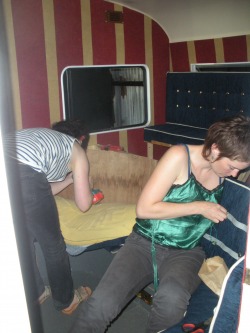 Presumably reasoning that no classic cinema house can go without something for reclining audience members to observe, they painted a fresco on the ceiling.
Presumably reasoning that no classic cinema house can go without something for reclining audience members to observe, they painted a fresco on the ceiling.
Furlong and co. fashioned a projector housing from a 1920s theatre light. Fitting that with a projector, and powering the machine, was the most technically complex aspect of construction because they wanted to make their cinema 100 percent solar-powered. A colleague, David Lloyd-Jones, fashioned a photovoltaic array of 120-watt panels that draws energy from the Sun that charges batteries that allow Sol Cinema staff to run their projector dependably day or night, rain or shine.
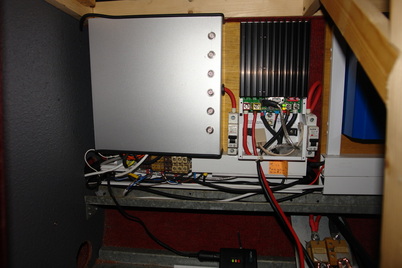 O’Connor and Furlong say they wanted to make attending the Sol Cinema an experience – seems it would already have been that – so they designed an atmosphere reminiscent of the 1940s “heyday of cinema.” So their cinema comes complete with vintage-dressed usherettes who escort audience members from a five-metre red carpet to their seats a metre or two away. Among the Sol usherettes are a talented portrait painter, an organic small-hold farmer, a sculptor, and a violinist who performs in mirror-laden dress.
O’Connor and Furlong say they wanted to make attending the Sol Cinema an experience – seems it would already have been that – so they designed an atmosphere reminiscent of the 1940s “heyday of cinema.” So their cinema comes complete with vintage-dressed usherettes who escort audience members from a five-metre red carpet to their seats a metre or two away. Among the Sol usherettes are a talented portrait painter, an organic small-hold farmer, a sculptor, and a violinist who performs in mirror-laden dress.
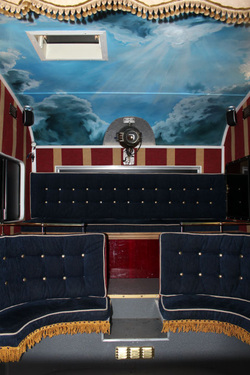 Within the theatre, of course, is a popcorn machine.
Within the theatre, of course, is a popcorn machine.
As the caravan began in 2010 to move about the UK from its base in Swansea, South Wales, it quickly gained attention from newspapers and other media outlets. O’Connor told one: “Cinemas have gone down the high budget route lately, so some people can’t afford to enjoy them any more. Films are costing millions to make with CGI and explosives racking up the bill — but we have stripped it right back. We have the technology to run lights, sound systems and a projector using just sunlight.”
That aspect of the Sol Cinema makes it attractive to environmentally aware publications and patrons. Also striking is the cost of admission: generally, nothing. Events, festivals, or locations that book the cinema meet costs of operation.
 The caravan cinema works with hundreds of short-film makers around the world, several of whom have come to the UK to attend a Sol screening of their work. O’Connor the projectionist selects a film, or asks audiences what they’d like to see from his collection. The close quarters create a “buzz among the people watching the films and it’s a close, personal experience in which they all share something,” he told one reporter. “People always walk out of Sol Cinema laughing; it seems to lift spirits.”
The caravan cinema works with hundreds of short-film makers around the world, several of whom have come to the UK to attend a Sol screening of their work. O’Connor the projectionist selects a film, or asks audiences what they’d like to see from his collection. The close quarters create a “buzz among the people watching the films and it’s a close, personal experience in which they all share something,” he told one reporter. “People always walk out of Sol Cinema laughing; it seems to lift spirits.”
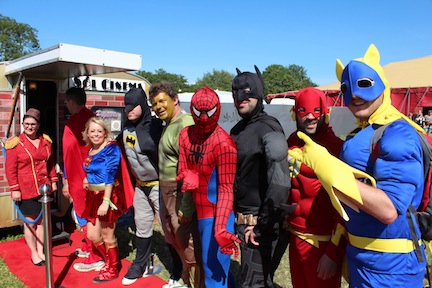
Yes: as an audience member, you may act the goat at the Sol Cinema
Thanks to the brevity of films, an audience member who misses one show time doesn’t have to wait around long for the next.
Part of the humour of the Sol is that it parodies mainstream cinema, not a bad way to make the films it presents more memorable. Those may include independent shorts from the city that brings the caravan to town. In 2013 Sol Cinema was invited to the legendary Glastonbury festival, and there Furlong and company presented a 60-second version of Harry Potter. Among their markets are community events and corporate functions that can hire Sol Cinema to show off a promotional video or to entertain clients.
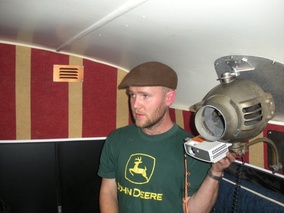 It was, in fact, another entertainment project that inspired the Sol Cinema wunderkammer. Some of the core Sol crew worked with The Dukes Box, a custom built audio-visual show that crams an entire gold-and-spandex little big band plus sound system plus light show into a jukebox fashioned from a “rather dead 1960s two-berth caravan” the size of a wardrobe. The band plays jazz, folk, rock, rap, techno, reggae, bluegrass (Morris dancing inside theatre not advised), hip hop, thrash metal, tunes from the top-40 of the moment, and of course 16th century ballads.
It was, in fact, another entertainment project that inspired the Sol Cinema wunderkammer. Some of the core Sol crew worked with The Dukes Box, a custom built audio-visual show that crams an entire gold-and-spandex little big band plus sound system plus light show into a jukebox fashioned from a “rather dead 1960s two-berth caravan” the size of a wardrobe. The band plays jazz, folk, rock, rap, techno, reggae, bluegrass (Morris dancing inside theatre not advised), hip hop, thrash metal, tunes from the top-40 of the moment, and of course 16th century ballads.
After Sol Cinema’s trip to the Glastonbury mud-and-music-fest in 2013, this year its organizers hope for a 2014 Europe tour. Furlong and co. intend to make a splash at the Cannes Film Festival, invited or not. All they’d really need is a small patch of Cannes street corner, field, or parking lot. Their pitch: “We arrive with fully charged batteries with enough power to run the cinema even if the Sun doesn’t shine.”
— Peter Monaghan
Printed from Moving Image Archive News: https://www.movingimagearchivenews.org
URL to article: https://www.movingimagearchivenews.org/cinema-from-the-sun/
Click here to print
